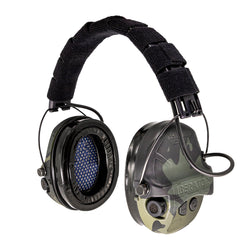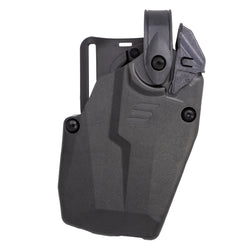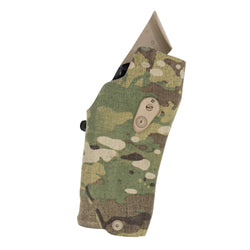Choosing a handgun isn’t difficult, but choosing the right handgun can be a little trickier. I, like many people, have purchased my fair share of the wrong guns, and I’d like to help others avoid that fate.
Buying the wrong gun becomes a costly affair. Handguns, in particular, tend to be purchased for personal protection, and while that will be the main focus of our article today, we will dive into a few other uses worth mentioning.

We’ll explore various types of handguns, handgun sizes, ergonomics, calibers, and more to help you make an informed decision about choosing the right handgun.
Identify Its Purpose
Rarely can one handgun do it all. To find the right one to fit your needs, you have to figure out what you intend to do with your handgun.
There are four main categories of handgun purposes: self-defense, competition, hunting, and plinking.
Self-Defense
Most people are buying handguns for personal protection, namely concealed carry, but home defense is another valid reason to own a handgun. Self-defense handguns are a broad category, which is why most of this article will focus on finding the right one.

A self-defense handgun needs to be fairly easy to shoot, potentially easy to carry, chamber a capable caliber, and be capable of total reliability.
Competition
Competition handguns are designed to shoot as fast and as straight as possible. To achieve this goal, you might get a handgun with features you wouldn’t use on a self-defense handgun, like a barrel weight or charging handle. Competition guns might even sacrifice certain modern safety features to provide a gun that shoots faster and straighter.
To choose a competition handgun, you’ll need to have a solid grasp on the rules of your chosen competition. Typically, competition shooting will have different classes that dictate a firearm’s size, its features, accessories, magazine capacity, and more. When choosing a discipline, you’ll need to understand these rules and pick a handgun that fits within those rules.

Hunting
Plenty of folks seem to enjoy handgun hunting, and they have a whole host of special requirements. The most important thing is the capability of your handgun to humanely kill your chosen game. The gun suited for killing deer is different than the gun suited to killing a bear.
Handgun hunters will typically push into magnum calibers, with .357 Magnum being the smallest cartridge. Revolvers are a common choice with a sprinkling of semi-autos. Barrels are typically longer, and optics are common.

Plinking
Plinking is the ancient art of shooting just for the joy of shooting. Any gun can be a plinking pistol. This is the least important category of handguns by far.
You don’t have to be overly selective, but a modern semi-auto .22LR is a great plinking platform. There is an overabundance of semi-auto .22LRs on the market.

Caliber Choice
Caliber has to match your goal. Competition rules will often dictate acceptable calibers, with categories and power level restrictions based on particular calibers and their energy.
Hunters have to match their caliber to their game and follow hunting laws. Hunters will typically prefer a powerful, deep-penetrating cartridge that can punch through muscle and fat.

Self-defense is where we see a massive amount of calibers competing for your attention. It’s important to understand how terminal ballistics apply to handguns. Handguns are not capable of generating secondary wounding characteristics; they only damage the part of the target they touch.
Handgun rounds do not fragment reliably; they don’t cause tremendous temporary cavities; they just beat a path through meat. This means the most important factor is penetration. A handgun cartridge needs to penetrate deep enough to reach something vital, namely the heart or brain.
The FBI standard is 12 inches of penetration through properly calibrated ballistic gel, with 18 inches being the desired maximum. If your round can reliably penetrate to this range, you have a capable caliber.

Most modern centerfire rounds will allow you to have adequate penetration with a jacketed hollow point that can expand and deal more damage as it travels through the body. Rounds like 9mm, .40 S&W, .45 ACP, .357 Magnum, and .38 Special are common cartridges for self-defense that provide adequate penetration.
No Such Thing As Stopping Power
There is no major difference between these rounds when it comes to effectively stopping a target. A 9mm will stop a threat just as efficiently as a .45 ACP and .357 Magnum. Things like stopping power simply don’t exist. Proper shot placement and penetration are what matter.
Smaller calibers like 9mm allow for manageable recoil and increased capacity over other rounds. It’s the best of all worlds for self-defense, and that’s why it’s become the mainstay of concealed carry and duty guns.

If you wanted to go even smaller, then .32 ACP, .380 ACP, and even .22LR can reach adequate penetration standards. The downside to these rounds is a greater likelihood of deflection and penetration loss when striking bone, as well as a loss of expanding projectiles.
With smaller guns, the smaller calibers make more sense. I tend to prefer .32 ACP and .22LR over .380 ACP for pocket pistols purely for recoil management purposes. The smaller calibers with less recoil have faster, more accurate follow-up shots.
Size
There is no “one size fits all” approach with handguns, and they come in every size you could imagine. There is a simple rule of thumb you have to remember when purchasing handguns: Smaller guns are easier to conceal, but harder to shoot.
You have to find the right compromise of size and control if concealment is a concern. If concealment isn’t a concern, my advice tends to be bigger is better in terms of gun frame size (but not necessarily caliber).

Fit and feel are two more factors in finding the right-sized handgun. Fit means you can easily reach and access all the gun’s controls and effectively control the weapon. “Feel” means it feels good in your hands, and fit is more important than feel.
You should be able to easily rack the slide, remove the magazine, lock or drop the slide, and access any safeties or decockers. If the gun is too small or too large, it becomes more challenging to shoot.
Dimensions
We live in a 3D world, so you have to consider a firearm’s length, height, and width. Firearm size could depend on caliber and magazine capacity. For example, the Glock 20 is a double-stack 10mm, and it’s too big for a lot of people.
Sometimes a single-stack 9mm, like the G43X, is a better choice than the double-stack Glock 19 due to the thinner grip. They are both 9mm Glocks, but one is considerably thinner than the other.

You should be able to reach your controls and form a tight, solid grip on your firearm. If you are barely hanging on to the gun, it’s too big and can be more difficult to control.
Too small is a little different due to the sacrifices you make for concealment. Optimistically, the grip will fill your hand from top to bottom, but for concealment, this may be sacrificed.
It’s best to handle a firearm prior to purchasing. Ensure you can reach the trigger without stretching your hand. Make sure you can activate the safety, release the magazine, activate the slide lock, and any other controls.

Weight can be great for reducing recoil and might be desirable for a competition pistol. However, weight can be a massive challenge when it comes to concealed carry. It’s uncomfortable and pulls at your pants. Carry guns tend to be better suited with lightweight designs.
What About The Trigger?
There is a lot of hubbub about triggers. People want these match-style triggers, and for a competition pistol, that might be important. But most people aren’t good enough with a gun for a competition trigger to make a difference in their match performance.
Triggers aren’t that big of a deal when it comes to accuracy or speed. A nice trigger is nice, but if you can’t shoot with your average modern trigger, it’s not the arrow; it’s the shooter.
In most cases, if the trigger is creating accuracy issues, you need to work on your grip more than your trigger.
There are exceptions. If the trigger is so heavy that pulling it disrupts your sight picture, then it’s a problem. With modern striker-fired guns, this isn’t a problem, but with something like a Russian Makarov, I can see the argument. Those guns will build grip strength with their long, heavy triggers.
If you’re shooting a modern striker-fired gun, or even a modern double action, don’t worry about the trigger. Worry about your skill and build good grip fundamentals.

Getting Picky With It
You should be picky about your choice of handgun. It shouldn’t be a decision you make lightly, especially when hundreds of dollars are at stake. You need to find a gun that fits.
- It should fit your chosen handgun activity.
- It also needs to fit an appropriate caliber.
- It should fit your hand.

Fit is critical when it comes to handgun choice, and I always advocate getting firsthand experience with a new gun before purchase. It’s not great to buy a handgun blindly, especially if it’s your first handgun. Get out there, get a grip, and give your local mom-and-pop shop some love.
If possible, rent your gun of choice, take a class, and try out class loaners. You’ll be glad you took the time to find the handgun that’s best for you.









